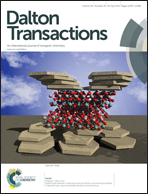New topology of CN-bridged clusters: dodecanuclear face-sharing defective cubes based on octacyanometallates(iv) and nickel(ii) with diimine ligands†
Abstract
New dodecanuclear bimetallic Ni8M4 clusters were obtained in the reaction between octacyanometallates(IV), nickel(II) cations and diimine ligands. {[Ni(LL)(H2O)]2[Ni(LL)(H2O)2]6[M(CN)8]4} assemblies, where LL = 1,10-phenanthroline M = Mo, (1) or LL = 2,2′-bipyridine M = W (2) or Mo (3), are among the largest octacyanometallate-based clusters. They show the same compact topology of the cluster core, which can be described as defective face-sharing cubes with corners defined by alternating metal centres. The structures are stabilised by π–π interactions between aromatic rings of diimine ligands and hydrogen bonds connecting terminal CN groups and coordinated H2O molecules through a crystallisation solvent. Different decorating ligands cause different arrangements of clusters in the crystal structure. 1 crystallises in the triclinic system space group P![[1 with combining macron]](https://www.rsc.org/images/entities/char_0031_0304.gif) , while 2 and 3 crystallise in the monoclinic system space group P21/n. The clusters show paramagnetic behaviour with weak antiferromagnetic interactions between the NiII centres through diamagnetic NC–MIV–CN linkages.
, while 2 and 3 crystallise in the monoclinic system space group P21/n. The clusters show paramagnetic behaviour with weak antiferromagnetic interactions between the NiII centres through diamagnetic NC–MIV–CN linkages.


 Please wait while we load your content...
Please wait while we load your content...